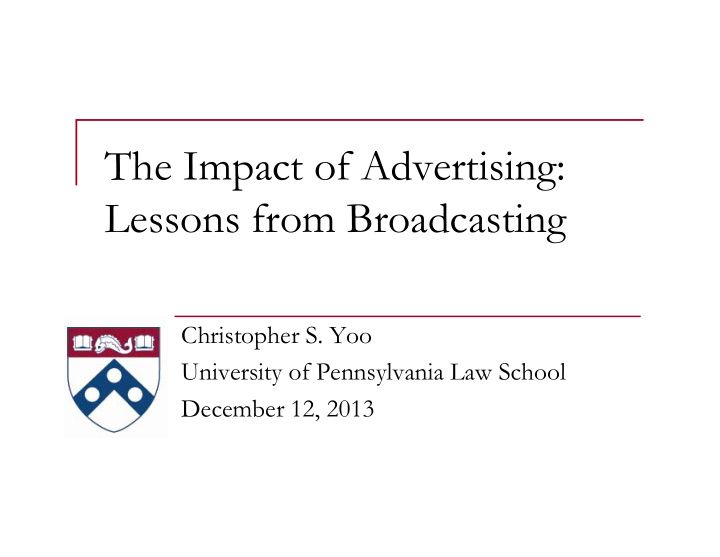



The Impact of Advertising: Lessons from Broadcasting Christopher S. Yoo University of Pennsylvania Law School December 12, 2013
The FCC’s Longstanding Preference for Free Television and Radio Television Opposition to subscription TV (overturned by D.C. Cir.) Cable: superstations, bundling, antisiphoning, network nonduplication, syndication exclusivity, must carry Satellite distant signal importation, carry one, carry all Digital television transition via broadcasting Radio (conventional and satellite) Confounded with commitment to local December 12, 2013 Yoo - Advertising and Broadcast Television 2
Impact on Total Revenue Theoretically ambiguous Pay models reflect audiences’ preferences for programs Advertising models reflect responsiveness to advertising Empirically clear Noll, Peck & McGowan (1973): pay = 7x advertising Effect confirmed by Levin (1971); Besen & Mitchell (1974); Spence & Owen (1977); Ellickson (1979); Park (1980); Holden (1993); Hansen & Kyl (2001) December 12, 2013 Yoo - Advertising and Broadcast Television 3
Pricing vs. Voting Models Pricing: two ways to signal intensity of preferences Viewing vs. nonviewing Price (revenue not just a function of audience size) Voting: only one way to signal preferences (viewing) Revenue (primarily) a function of audience size CBS derives 1/8 the revenue per viewer as HBO Implications Program quality falls (HBO’s dominance of the Emmys) Programs with small audiences cannot survive (diversity) December 12, 2013 Yoo - Advertising and Broadcast Television 4
The Advertiser as Intermediary Biased towards demographics most responsive to advertising Instills consumerist mentality (avoid controversy) Subjects content to advertisers’ political preferences and vulnerabilities NBC’s Roe v. Wade vs. HBO’s Roe v. Wade HBO: “We’re not any braver than the other networks. It’s just that our economic basis is different.” Viacom’s shift of The Reagans from CBS to Showtime December 12, 2013 Yoo - Advertising and Broadcast Television 5
Importance of Two-Sided Markets Network consists of two types of actors Value is determined by number of other type Advertising is a classic two-sided market Two types of actors: subscribers and advertisers Value to advertisers determined by no. of subscribers Natural flow: advertisers → last-mile providers History of broadcast network economics Logic of paid peering December 12, 2013 Yoo - Advertising and Broadcast Television 6
Implications for the Internet Advertisers introduce considerations unrelated to end users’ preference for content Ads are the product of choice, not regulation Do online ads understate end user preferences? Do online ads reflect intensity of preferences? Are content → last-mile payments beneficial? (Netflix, ESPN, etc.) Wireless may mitigate problems (lesser reliance on ads, greater willingness pay for apps) December 12, 2013 Yoo - Advertising and Broadcast Television 7
References Yoo, Christopher S. (2003). “Rethinking the Commitment to Free, Local Television.” Emory Law Journal 52(4): 1579- 1717, at 1668-82. Yoo, Christopher S. (2005). “Architectural Censorship and the FCC.” Southern California Law Review 78(3): 669-731, at 676-85. Yoo, Christopher S. (2009). “Network Neutrality after Comcast : Toward a Case-by-Case Approach to Reasonable Network Management,” in Randolph J. May ed., New Directions in Communications Policy. Carolina Academic Press pp. 55–84. December 12, 2013 Yoo - Advertising and Broadcast Television 8
Recommend
More recommend